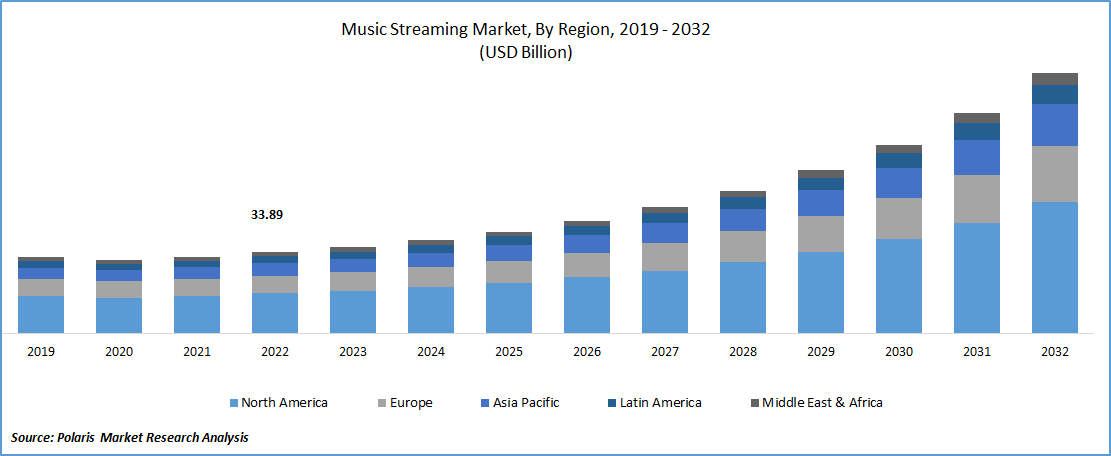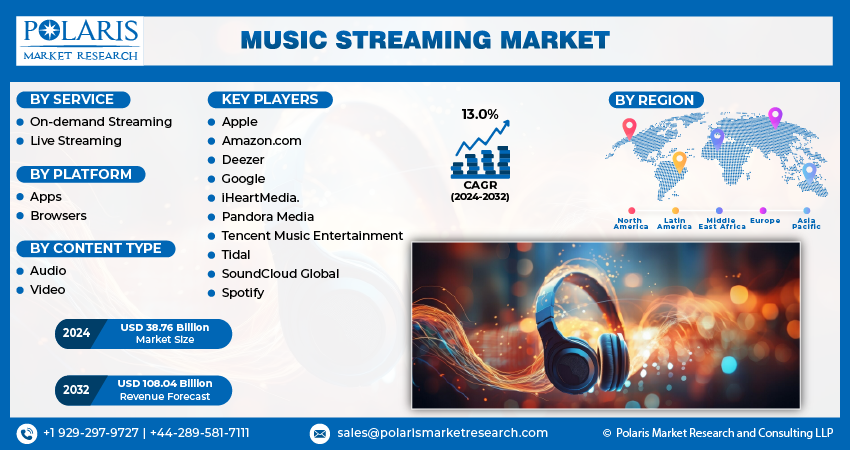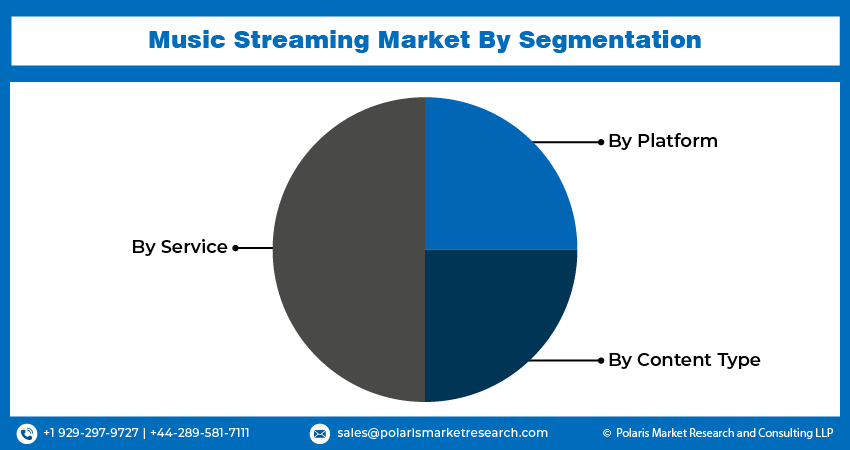
Music Streaming Market Size, Share, Trends & Industry Analysis Report
: By Service (On-demand Streaming and Live Streaming), By Platform, By Content Type, By End Use, and By Region– Market Forecast, 2025–2034
- Published Date:Jun-2025
- Pages: 130
- Format: PDF
- Report ID: PM3773
- Base Year: 2024
- Historical Data: 2020-2023
The music streaming market size was valued at USD 46.12 billion in 2024, exhibiting a CAGR of 14.7% during 2025–2034. The music streaming market is driven by rising smartphone penetration, affordable internet access, on-demand content demand, personalized user experiences, smart device integration, and the shift from physical to digital music consumption.
Market Overview:
The music streaming market encompasses online services that provide music, podcasts, and other audio files in streaming format, eliminating the need for users to download or permanently save the files. Users can access these services through subscriptions or advertisements, offering an extensive collection of songs across various genres from countless artists. This content can be enjoyed on smartphones, smart speakers, and computers. The convenience, availability of content, and seamless listening experience these services provide have redefined music ownership, converting it into an easily accessible digital format, which has also shifted industry dynamics and consumer behavior.
The rapid adoption of smartphone technology and the widespread availability of high-speed internet are critical factors that facilitate streaming on multiple devices. These developments primarily accelerate the growth of subscription-based models, which allow ad-free listening and offer additional features. Paid subscriptions enhance user engagement and generate revenue, making user retention policies increasingly important. Furthermore, advancements in artificial intelligence (AI) and machine learning (ML) boost demand by improving user retention through personalized playlists and recommendation systems, as well as tailored marketing and video advertising.

To Understand More About this Research: Request a Free Sample Report
Industry Dynamics:
Ubiquitous Device Penetration and Internet Access
The widespread adoption of smartphones and increasing global internet access are key drivers of the music streaming market. The rise of affordable smartphones, combined with enhanced broadband infrastructure and mobile data networks, has created a large user base with constant access to online content. For example, data from the Pew Research Center in June 2024 shows that approximately 91% of adults in the United States own a smartphone, a significant increase from 35% in 2011. This highlights the availability of devices capable of streaming audio content. The extensive connectivity allows consumers to easily access vast music libraries anytime and anywhere, promoting a significant shift from traditional media consumption to on-demand digital formats. This high penetration directly fuels the growth potential and demand for music streaming services.
Enhanced Content Accessibility and Convenience
Enhanced content accessibility and convenience are major drivers in the music streaming market, significantly transforming how users consume music. Streaming platforms provide instant access to extensive music libraries without the need to purchase or download individual tracks, allowing users to explore millions of songs anytime and anywhere. This eliminates physical storage limitations and enables seamless listening across multiple devices, such as smartphones, tablets, laptops, and smart speakers. Additionally, user-friendly interfaces, offline listening options, and personalized playlists enhance convenience by tailoring music experiences to individual preferences. The ability to discover new artists and genres effortlessly through algorithm-driven recommendations further enriches user engagement. These factors collectively encourage widespread adoption of streaming services, boosting market growth as consumers prioritize easy, flexible, and on-demand music access over traditional formats.
Advanced Personalization through AI and Machine Learning
Advanced personalization driven by AI and machine learning is transforming the music streaming market by providing tailored listening experiences. These technologies analyze user behavior, preferences, and listening patterns to create customized playlists, recommend new artists, and generate mood-based or activity-specific music selections. This level of personalization enhances user engagement and satisfaction, leading to longer listening sessions and higher subscription rates.
Furthermore, AI-powered features like voice recognition and smart search improve usability and accessibility, making it easier for users to discover content they love. By continually learning from user interactions, these platforms adapt to changing tastes, boosting user loyalty and reducing churn. This, in turn, fuels growth and competitiveness within the music streaming industry.

Segmental Insights:
Market Assessment By Service
On-demand streaming is projected to dominate the market during the forecast period, primarily due to its extensive catalogs of music and podcasts. This sub-segment offers vast libraries that provide unmatched convenience. By utilizing a convenience-driven approach, on-demand streaming allows users to listen to a wide variety of content on multiple devices. It has become the most popular form of digital audio consumption, surpassing physical media like CDs and downloads. Easy access to a diverse range of genres—such as pop, rock, jazz, and classical music—without the need for physical storage is essential.
Live music is the fastest-growing segment anticipated for upcoming years. This sub-segment includes real-time performances, virtual concerts, and interactive sessions with artists, marking a new era of audience engagement. As technology continues to advance, the demand for more compelling experiences increases, opening up new avenues for interaction between artists and fans through live streaming.
Market Evaluation By Platform
The apps segment is expected to hold the largest market share during the forecast period. This is mainly due to the widespread adoption of smartphones and other smart devices, as well as the increased user satisfaction provided by proprietary or “native” apps. These applications offer full compatibility with device functions, such as offline song downloads, personalized reminders, advanced audio level management, and a simple yet attractive design. Their aim is to improve portability and make the product easier for modern consumers to use.
Market Evaluation By Content Type
Audio content primarily dominates the music streaming market because listening to music is the main reason people use these services.Users of audio-only streaming platforms expect high-quality audio streaming, access to extensive song libraries, playlists, and even podcasts. This is essential for many individuals who want to enjoy music while busy or on the go. The ability to listen to a wide range of genres and experience smooth transitions between tracks places audio at the forefront of music streaming offerings.
In contrast, video programming categorized as music is growing at a faster rate than audio content. This category includes officially released music videos, concert recordings, visual albums, and short videos created by the artists themselves. The integration of visual elements with audio enhances the experience and meets the demand for greater audience engagement. Additionally, the popularity of music videos on various social media and niche video platforms contributes to expanding outreach and attracting new listeners.
Market Evaluation By End Use
Individual end-use accounts for the largest share of the music streaming market, primarily driven by direct consumer subscriptions and ad-supported free tiers. The significant number of individual users is attributed to the increased use of personal devices like smartphones and tablets. The easy availability of music for entertainment during commuting or as background music for various activities encourages users to seek customizable listening experiences along with variety and on-demand availability.
Although the commercial end-use segment is rapidly gaining traction in the music streaming services market. Retail businesses, hospitality establishments, fitness studios, and broadcasting companies are beginning to recognize the marketing potential of properly licensed music and its positive impact on customer experience, brand perception, and adherence to copyright regulations. This growth is further supported by the emergence of business-to-business (B2B) music streaming services, which offer ready-made compliant playlists, flexible management options, and other essential tools.

Regional Analysis
The North American music streaming market consistently holds the largest share in the overall music streaming industry. This dominance can be attributed to several factors, including widespread internet access, the prevalence of smartphones, and the popularity of digital media. Major streaming platforms and established content creators cater to a relatively affluent population, making it easy for people to access streaming services. As a result, this convenience enhances America's position in the global music industry.
There has been a significant shift from traditional methods of accessing music to streaming, as it offers easier access to modern playlists and vast, personalized libraries. The existing infrastructure provides excellent support and security for musicians, contributing to the recovery of the global market for music streaming services.
The Asia-Pacific music streaming market is experiencing the highest growth rate during the forecast period. This growth is driven by increasing smartphone penetration, expanding internet connectivity, and the emergence of a growing middle class. Countries in this region are rapidly evolving into digital economies, leading to a surge in new internet users and an increased demand for online entertainment. Additionally, the availability of rich local content complements the efforts of global and local streaming services, which often utilize strategic marketing and competitive pricing models. With significant demand shifts and enormous potential, this region is poised to lead the world in music streaming service growth in the future.

Key Players and Competitive Insights
The competition for music streaming services is fierce and constantly evolving. Businesses aim for user focus and their subscriptions by widening their catalogs, advanced user experience methods, and interactions with other companies. Strategic partnerships also help in gaining user attention. The continuous focus on exclusiveness, such as podcasts, live performances, high-fidelity audio, and extensive social media sharing, drives companies to outdo each other. Different streaming services are offered under unique payment models, from ad-supported to free services and paid premium packages. Each model is designed to appeal to a wide range of listeners and creators, meaning stronger user retention.
List of Key Companies:
- Amazon Music (Amazon.com, Inc.)
- Apple Music (Apple Inc.)
- Deezer (Deezer S.A.)
- LiveOne
- Pandora (SiriusXM)
- Qobuz
- SoundCloud
- Spotify (Spotify Technology S.A.)
- Tidal (Block, Inc.)
- YouTube Music (Alphabet Inc.)
Industry Developments
- May 2025: Apple Music (Apple Inc.) collaborated with Universal Music Group to introduce "Sound Therapy," an innovative audio wellness collection. This new offering leverages cognitive science and UMG's extensive roster of artists, adding subtle auditory beats to curated tracks.
- April 2024: Spotify launched the "AI Playlist" feature, allowing users to generate playlists from creative prompts.
Market Segmentation
By Service Outlook (Revenue – USD Billion, 2020–2034)
- On-demand Streaming
- Live Streaming
By Platform Outlook (Revenue – USD Billion, 2020–2034)
- Apps
- Browsers
By Content Type Outlook (Revenue – USD Billion, 2020–2034)
- Audio
- Video
By End Use Outlook (Revenue – USD Billion, 2020–2034)
- Individual
- Commercial
By Regional Outlook (Revenue-USD Billion, 2020–2034)
- North America
- US
- Canada
- Mexico
- Europe
- Germany
- France
- UK
- Italy
- Spain
- Netherlands
- Russia
- Rest of Europe
- Asia Pacific
- China
- Japan
- India
- Malaysia
- South Korea
- Indonesia
- Australia
- Vietnam
- Rest of Asia Pacific
- Middle East & Africa
- Saudi Arabia
- UAE
- Israel
- South Africa
- Rest of Middle East & Africa
- Latin America
- Brazil
- Argentina
- Rest of Latin America
Market Report Scope:
|
Report Attributes |
Details |
|
Market Size Value in 2024 |
USD 46.12 billion |
|
Market Size Value in 2025 |
USD 52.79 billion |
|
Revenue Forecast by 2034 |
USD 181.39 billion |
|
CAGR |
14.7% from 2025 to 2034 |
|
Base Year |
2024 |
|
Historical Data |
2020–2023 |
|
Forecast Period |
2025–2034 |
|
Quantitative Units |
Revenue in USD billion and CAGR from 2025 to 2034 |
|
Report Coverage |
Revenue Forecast, Market Competitive Landscape, Growth Factors, and Industry Insights |
|
Segments Covered |
|
|
Regional Scope |
|
|
Competitive Landscape |
|
|
Report Format |
|
|
Customization |
Report customization as per your requirements with respect to countries, regions, and segmentation. |
FAQ's
The global market size was valued at USD 46.12 billion in 2024 and is projected to grow to USD 181.39 billion by 2034.
The market is projected to register a CAGR of 14.7% during the forecast period, 2024-2034.
North America had the largest share of the market.
Some key players include Spotify (Spotify Technology S.A.), Apple Music (Apple Inc.), Amazon Music (Amazon.com, Inc.), YouTube Music (Alphabet Inc.), Deezer (Deezer S.A.), Pandora (SiriusXM), Tidal (Block, Inc.), SoundCloud, Qobuz, and LiveOne.
The audio segment accounted for the largest share of the market in 2024.
The following are some of the market trends: ? Greater Use of AI Technology: Platforms use artificial intelligence and machine learning to create a more intimate experience for listeners through tailored playlists, the uncovering of new artists, and song suggestions based on the listener's current mood. ? Higher Standards for Audio Fidelity: There is increased demand and a push for the availability of higher-fidelity and lossless audio streaming. More platforms geared towards audiophiles are providing better sound quality.
Music streaming is the process of providing access to music, podcasts, and other audio files over the Internet in real time. Streaming allows users to listen without first needing to download and store files. Users no longer possess digital files or physical media, but rather have access to a catalog of content. This process comprises the sending of data packets by a service's server to the user's device, which requires buffering of the sound from the beginning so that playback can commence immediately. This allows for instant listening, smooth browsing through large catalogs, and bypassing the need to navigate a long list of songs.
